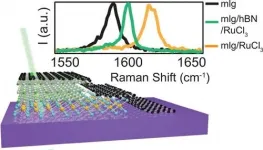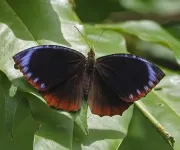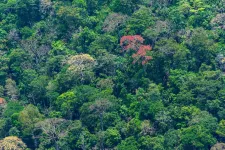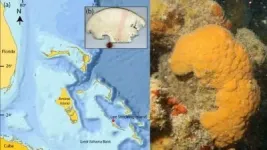New way to control electrical charge in 2D materials: Put a flake on it
2021-01-14
(Press-News.org) Physicists at Washington University in St. Louis have discovered how to locally add electrical charge to an atomically thin graphene device by layering flakes of another thin material, alpha-RuCl3, on top of it.
A paper published in the journal Nano Letters describes the charge transfer process in detail. Gaining control of the flow of electrical current through atomically thin materials is important to potential future applications in photovoltaics or computing.
"In my field, where we study van der Waals heterostructures made by custom-stacking atomically thin materials together, we typically control charge by applying electric fields to the devices," said Erik Henriksen, assistant professor of physics in Arts & Sciences and corresponding author of the new study, along with Ken Burch at Boston College. "But here it now appears we can just add layers of RuCl33. It soaks up a fixed amount of electrons, allowing us to make 'permanent' charge transfers that don't require the external electric field."
Jesse Balgley, a graduate student in Henriksen's laboratory at Washington University, is second author of the study. Li Yang, professor of physics, and his graduate student Xiaobo Lu, also both at Washington University, helped with computational work and calculations, and are also co-authors.
Physicists who study condensed matter are intrigued by alpha-RuCl3 because they would like to exploit certain of its antiferromagnetic properties for quantum spin liquids.
In this new study, the scientists report that alpha-RuCl3 is able to transfer charge to several different types of materials -- not just graphene, Henriksen's personal favorite.
They also found that they only needed to place a single layer of alpha-RuCl3 on top of their devices to create and transfer charge. The process still works, even if the scientists slip a thin sheet of an electrically insulating material between the RuCl3 and the graphene.
"We can control how much charge flows in by varying the thickness of the insulator," Henriksen said. "Also, we are able to physically and spatially separate the source of charge from where it goes -- this is called modulation doping."
Adding charge to a quantum spin liquid is one mechanism thought to underlie the physics of high-temperature superconductivity.
"Anytime you do this, it could get exciting," Henriksen said. "And usually you have to add atoms to bulk materials, which causes lots of disorder. But here, the charge flows right in, no need to change the chemical structure, so it's a 'clean' way to add charge."
INFORMATION:
Read more in Nano Letters: Modulation Doping via a Two-Dimensional Atomic Crystalline Acceptor
[Attachments] See images for this press release:

ELSE PRESS RELEASES FROM THIS DATE:
2021-01-14
ATLANTA--Compared to standard machine learning models, deep learning models are largely superior at discerning patterns and discriminative features in brain imaging, despite being more complex in their architecture, according to a new study in Nature Communications led by Georgia State University.
Advanced biomedical technologies such as structural and functional magnetic resonance imaging (MRI and fMRI) or genomic sequencing have produced an enormous volume of data about the human body. By extracting patterns from this information, scientists can glean ...
2021-01-14
Philadelphia, January 14, 2021--Based on preclinical studies of an investigational drug to treat peripheral nerve tumors, researchers at Children's Hospital of Philadelphia (CHOP) as part of the Neurofibromatosis Clinical Trials Consortium have shown that the drug, cabozantinib, reduces tumor volume and pain in patients with the genetic disorder neurofibromatosis type 1 (NF1). The results of the Phase 2 clinical trial, co-chaired by Michael J. Fisher, MD at CHOP, were published recently in Nature Medicine.
"This is the second class of drugs to demonstrate ...
2021-01-14
Many animal and insect species use Batesian mimicry - mimicking a poisonous species - as a defense against predators. The common palmfly, Elymnias hypermnestra (a species of satyrine butterfly), which is found throughout wide areas of tropical and subtropical Asia, adds a twist to this evolutionary strategy: the females evolved two distinct forms, either orange or dark brown, imitating two separate poisonous model species, Danaus or Euploea. The males are uniformly brown. A population group is either entirely brown (both males and females) or mixed (brown males and orange females).
City College of New York entomologist David Lohman and his collaborators studied the genome of 45 samples representing 18 subspecies across Asia to determine ...
2021-01-14
While new research from West Virginia University economists finds that presidential inaugurations have gained popularity as must-see tourist events in recent years, major security threats will keep visitors away for the inauguration of President-Elect Joe Biden.
Published in "Tourism Economics," the study, by Joshua Hall, chair and professor of economics, and economic doctoral student Clay Collins, examined the impact of the inaugurations of Barack Obama and Donald Trump on hotel occupancy in the Washington, D.C.-area.
Daily occupancy rates around the inaugurations were four-to-six times higher than the next largest event in the sample. The research team also concluded ...
2021-01-14
To achieve full occupancy, hotels used to rely exclusively on experience, concentration and human abilities. Then came online booking, which made the reservation collection process faster, but did not solve the risk of turning down long stays because of rooms previously booked for short stays.
To avoid overbooking (accepting more reservations than there is room for) in some cases online sales are blocked before hotels are completely booked. The solution that the University of Trento has just discovered could change the life of hotels by increasing the number of occupied rooms and, therefore, in the revenue of hotel owners.
For an average Italian hotel (50 rooms), ...
2021-01-14
More than half of all university students in the United States have experienced high levels of psychological impact from the COVID-19 pandemic, according to a new study published in the open-access journal PLOS ONE by Matthew Browning of Clemson University, US, and colleagues.
University students are increasingly recognized as a psychologically vulnerable population, suffering from higher levels of depression, anxiety, substance abuse and disordered eating compared to the general population. Moreover, college students have been among the most strongly affected by COVID-19 because of uncertainty regarding academic success, future careers and social life during college, among other concerns.
In the new study, researchers collected data on 2,534 students ...
2021-01-14
Investors who bet on tropical forest conservation and reforestation to solve global warming by storing carbon in wood face huge uncertainties because the science behind predicting carbon stocks is still shaky. Even the best Earth Systems Models fail to predict how carbon stored by tropical forests varies from place to place. The New Phytologist invites scientists doing the "most-exciting, ground-breaking research" to review timely topics in a way that non-scientists can understand. Helene Muller-Landau, staff scientist at the Smithsonian Tropical Research Institute (STRI) was chosen to write the authoritative Tansley Review ...
2021-01-14
MIAMI--Scientists used a 600-year-old marine sponge to reconstruct a record of ocean temperature in the North Atlantic revealing past volcanic activity as well as the current global warming trend from the release of carbon dioxide and other heat trapping gasses into Earth's atmosphere and absorbed by the oceans.
The University of Miami (UM) Rosenstiel School of Marine and Atmospheric Science-led research team used geochemical proxies to reconstruct a 600 year-long record of Atlantic Ocean temperatures from the skeleton of a sclerosponge (Ceratoporella nicholsoni).
The basketball-sized sclerosponge was ...
2021-01-14
These findings validate the significance of the previously described first threshold - the point when the damage to the acinar cells of the pancreas is sufficient to trigger the infamous inflammatory cascade (Barreto and Saccone, 2010) - while highlighting the importance of a second threshold, namely the point when a person develops clinical symptoms of the disease sufficient to warrant going to hospital.
"This transcontinental collaboration of pancreatologists drew on their vast clinical and research experience spanning decades investigating the pathophysiology and treatments ...
2021-01-14
Deep in the Brazilian Amazon River basin, scientists led by the Smithsonian's National Museum of Natural History fish research associate C. David de Santana discovered a small, river-fed lake filled with more than 100 adult electric eels, many of which were upwards of 4 feet long. On its own, this was an intriguing discovery, electric eels--a type of knifefish rather than true eels--were thought to be solitary creatures.
But in this lake along the banks of the Iriri River in Brazil's state of Pará, the researchers witnessed the eels working together to herd small fish called tetras into tightly packed balls. Then groups of up to ...
LAST 30 PRESS RELEASES:
[Press-News.org] New way to control electrical charge in 2D materials: Put a flake on it






